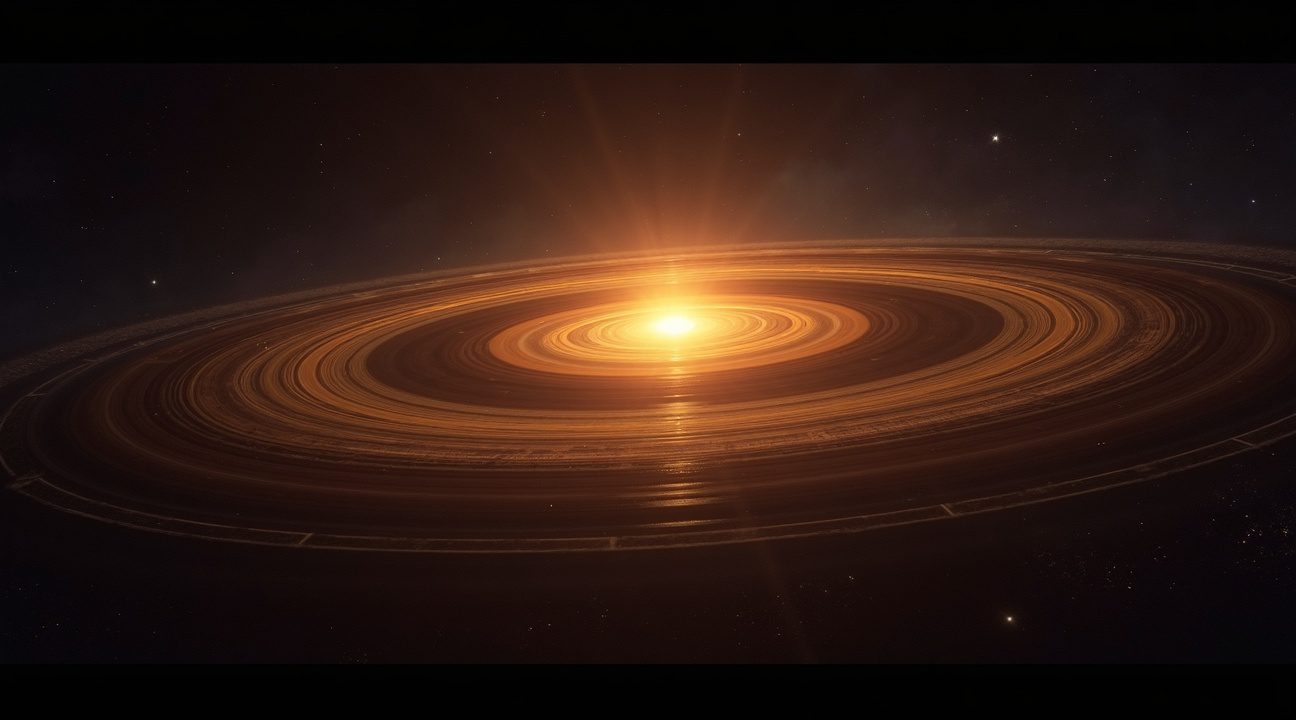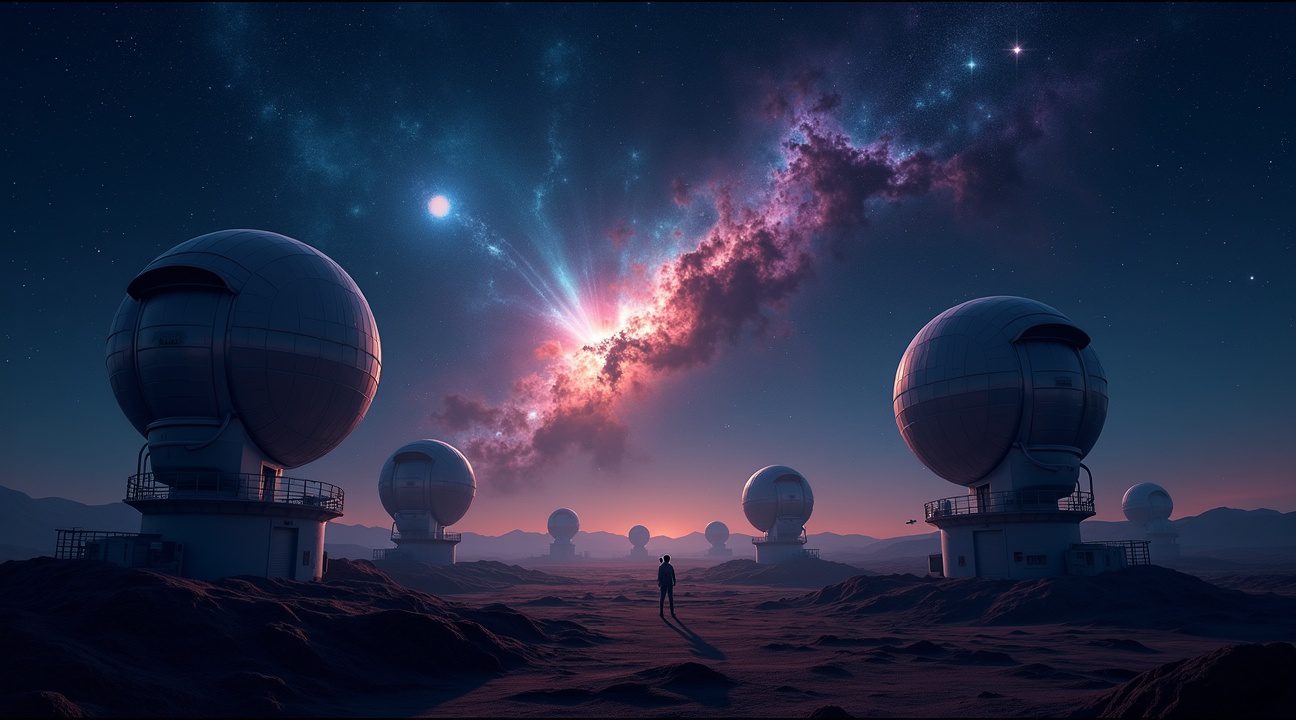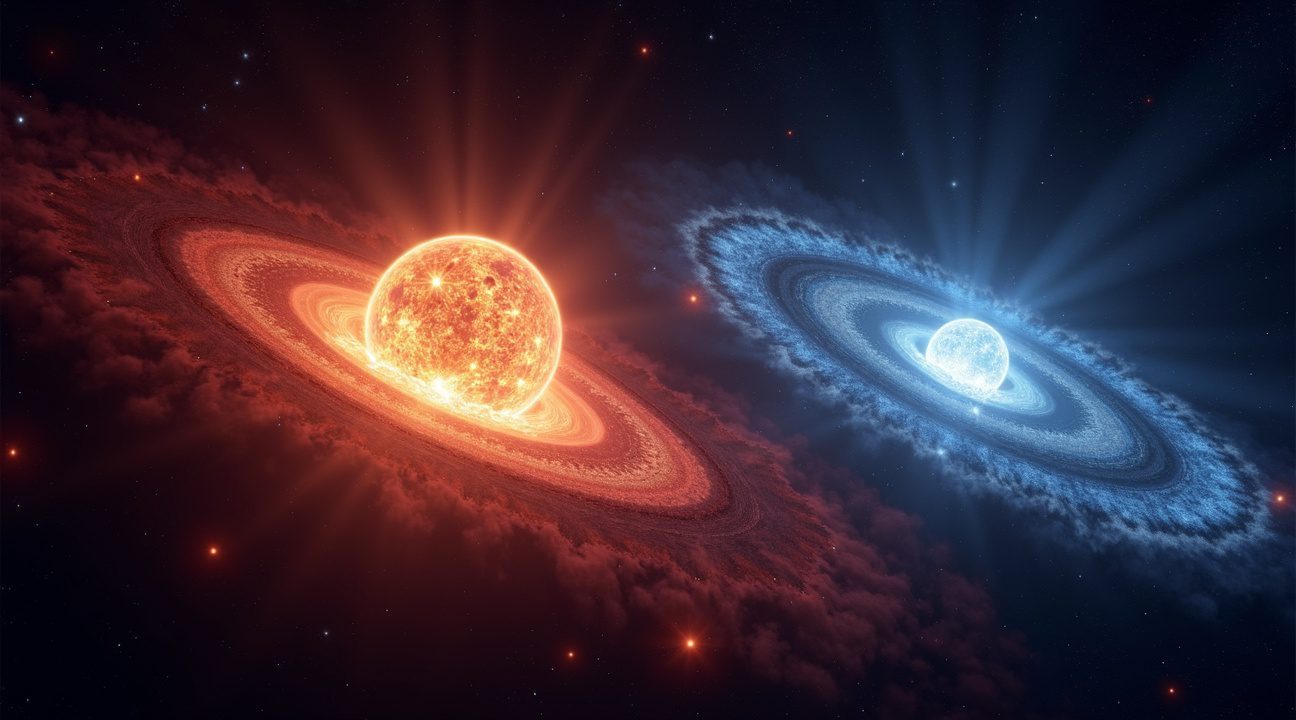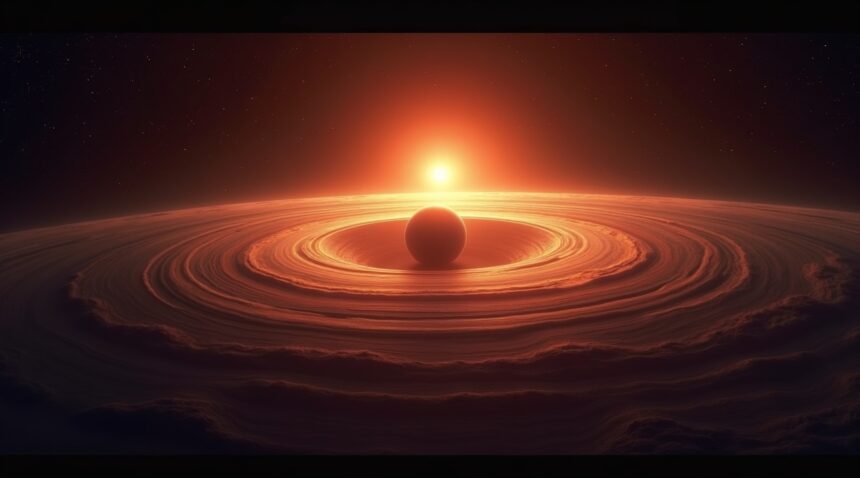Astronomers achieved a groundbreaking milestone by capturing the first direct image of WISPIT 2b, a newborn gas giant planet in the early stages of formation around a sun-like star. This extraordinary discovery marks only the second confirmed observation of a planet at such an early evolutionary stage. Scientists now possess an unprecedented window into how planetary systems develop in real-time.
Key Takeaways
- Direct imaging breakthrough: WISPIT 2b represents the first planet directly imaged from a multi-ringed protoplanetary disk system, offering higher confidence and detailed insights compared to indirect detection methods used for most exoplanet discoveries.
- Cosmic infant observation: At approximately 5 million years old, the host star and planet system provides a rare glimpse into planetary formation during its earliest phases, essentially capturing a cosmic birth photo of a developing planetary family.
- Revolutionary disk structure: The planet exists within a distinctive gap in a multi-ringed disk spanning 380 astronomical units, demonstrating how newborn planets actively sculpt their environment like cosmic snowplows while clearing material from their orbital paths.
- Advanced technology success: Multiple cutting-edge telescopes including the MagAO-X system, Large Binocular Telescope, and Very Large Telescope achieved this feat using adaptive optics and multi-wavelength detection to overcome atmospheric distortion.
- Formation timeline revelations: The discovery challenges previous models by showing that massive planet formation can occur much faster than previously thought, with gas giants potentially reaching substantial sizes within just a few million years.
Astronomers Witness the First Direct Image of a Baby Planet Being Born
I’ve witnessed groundbreaking moments in space exploration, but few discoveries match the significance of capturing a planet in its infancy. WISPIT 2b represents an extraordinary milestone in astronomical research, marking only the second confirmed observation of a planet at such an early evolutionary stage around a sun-like star.
This newly discovered gas giant exists within a distinctive gap in a multi-ringed disk of dust and gas surrounding its host star, WISPIT 2. The star itself resembles a younger version of our Sun, providing scientists with a remarkable window into how planetary systems develop. What makes this discovery particularly exceptional is that it’s the first direct image captured from a multi-ringed system of this type.
Direct Imaging Revolutionizes Planet Detection
WISPIT 2b’s discovery stands apart from typical exoplanet findings because astronomers confirmed its presence through direct imaging of emitted and reflected light. This method provides significantly higher confidence compared to indirect detection techniques that most planet discoveries rely upon. The ability to actually see the planet’s light offers unprecedented insights into its composition, temperature, and ongoing formation processes.
NASA’s Exoplanet Archive confirms nearly 6,000 exoplanets, yet the vast majority were detected indirectly through methods like transit photometry or radial velocity measurements. These indirect approaches, while effective for finding planets, can’t provide the detailed information that direct imaging offers about a planet’s characteristics and development.
The significance of this direct observation extends beyond simple detection. Scientists can now:
- Study the planet’s atmospheric composition
- Monitor its growth patterns
- Observe its interactions with surrounding disk material
This real-time observation of planetary formation provides critical data for understanding how gas giants develop and migrate within their stellar systems.
WISPIT 2b’s location within the disk gap suggests it’s actively clearing material from its orbital path, a process that demonstrates how planets carve out their space within stellar systems. This behavior offers valuable insights into the mechanisms driving planetary formation and evolution. The discovery builds upon recent advances in space exploration, similar to how India’s lunar missions have expanded our understanding of celestial bodies.
The implications of directly imaging such a young planet extend far beyond this single discovery. This achievement demonstrates that current telescope technology can capture planets during their formation phase, opening new possibilities for studying planetary birth processes. Future observations of WISPIT 2b will likely reveal:
- How quickly the planet accumulates mass
- How its atmosphere develops
- The environmental factors shaping its evolution in early stages
This marks a major step forward in unraveling the secrets of planetary genesis.
A 5-Million-Year-Old Cosmic Nursery Reveals Planetary Birth Secrets
The discovery of WISPIT 2b presents an extraordinary opportunity to witness planetary formation in action. This newborn planet’s host star is approximately 5 million years old, making it a cosmic infant compared to our own solar system’s 4.6 billion-year history. This age difference creates what researchers consider a rare glimpse into planetary system assembly during its earliest phases—essentially capturing a cosmic birth photo of a developing planetary family.
Extreme Youth Offers Scientific Gold Mine
WISPIT 2b’s extreme youth transforms it into a unique laboratory for studying planet-disk interactions. Scientists can observe firsthand how gas giants interact with and reshape their birth environments, processes that occurred billions of years ago in our own solar system but left only indirect evidence. The planet remains embedded within its formation environment, allowing researchers to study active accretion processes, disk clearing mechanisms, and chemical evolution as they happen rather than reconstructing them from ancient clues.
Unlocking Formation Timeline Mysteries
This discovery significantly advances our understanding of the cosmic timeline and physical mechanisms driving planetary birth. Key insights include several critical processes that shape early planetary development:
- Gas accretion rates and efficiency during the first few million years
- Disk clearing patterns and how massive planets carve gaps in their birth material
- Chemical evolution within young planetary systems and element distribution
- Migration patterns of gas giants during their formation phase
- Temperature and pressure conditions in active planetary nurseries
The findings challenge previous models about how quickly planets can form and mature. Recent space missions have provided new tools for detecting such young systems, but WISPIT 2b represents one of the youngest confirmed planets ever discovered. Its study reveals that massive planet formation can occur much faster than previously thought, with gas giants potentially reaching substantial sizes within just a few million years.
This research reshapes our understanding of solar system formation timelines. While our solar system took hundreds of millions of years to reach stability, WISPIT 2b suggests that certain planetary formation processes can proceed rapidly under specific conditions. The planet’s current state provides direct evidence of how gas accretion, gravitational interactions, and disk evolution work together during the critical early phases of planetary system development, offering invaluable data for refining formation models across the universe.
Revolutionary Multi-Ring Disk Structure Shows How Planets Sculpt Their Homes
The protoplanetary disk surrounding WISPIT 2 presents a fascinating multi-ring structure that offers unprecedented insights into planetary formation. This disk consists of multiple rings and gaps, creating a pattern that scientists increasingly recognize as the signature of newborn planets actively shaping their environment. I find these structures particularly compelling because they demonstrate how planets don’t just form passively—they actively sculpt their surroundings as they grow.
Planetary Snowplows at Work
WISPIT 2b operates like a cosmic snowplow within this dust and gas environment. The ring-forming planet clears material from its orbital path while simultaneously gathering mass for its own growth. These gaps act like lanes opened by heavy machinery, revealing the profound shaping influence that planets exert on their birthplace. I observe that WISPIT 2b sits within one such pronounced gap, providing direct evidence of its ongoing interaction with the surrounding disk material.
The scale of this disk structure defies easy comprehension. Measuring approximately 380 astronomical units across, this protoplanetary disk spans a truly vast distance. To put this in perspective, Earth orbits just 1 AU from the Sun, making this disk nearly 400 times wider than our planet’s orbital distance. This enormous expanse provides ample space for multiple planets to form and establish their own gravitational zones of influence.
The Vinyl Record Model
Scientists have developed a vinyl record analogy to help visualize how these disk structures function. Just as grooves on a spinning record create distinct channels for the needle to follow, the rings and gaps in WISPIT 2’s disk form organized patterns. Each disk gap represents a cleared zone where planetary formation has disrupted the original smooth distribution of material. The remaining rings contain concentrated dust and gas that continue feeding the formation process.
This analogy proves particularly useful because vinyl records also demonstrate how rotating systems naturally develop structured patterns. The protoplanetary disk spins around its central star, and gravitational forces from forming planets create repeating patterns of density and emptiness. I notice how this comparison helps explain why these systems appear so organized rather than chaotic, despite the violent processes occurring within them.
The multi-ring structure also reveals timing information about planetary birth. Different gaps suggest planets formed at various stages, creating a historical record embedded in the disk’s architecture. Some gaps appear crisp and well-defined, indicating recent or ongoing planetary activity. Others show signs of material beginning to refill them, suggesting older planets that have completed most of their formation.
Understanding these disk interactions provides crucial insights for space exploration missions and planetary science research. The patterns I observe in WISPIT 2’s disk likely mirror processes that occurred in our own solar system billions of years ago. Each ring and gap tells part of the story about how gravitational forces, material accretion, and orbital dynamics combine to create planetary systems.
The discovery challenges previous assumptions about planetary formation timelines. Rather than forming in isolation, planets clearly influence each other’s development through their shared disk environment. This interconnected process suggests that planetary systems develop as integrated units rather than collections of independent objects. The revolutionary nature of these observations lies in their ability to capture these dynamic processes in action, providing real-time documentation of planetary birth and early development.

State-of-the-Art Technology Captures Light From a Forming World
Astronomers achieved a remarkable feat by directly capturing light from WISPIT 2b using some of the most sophisticated observational instruments available today. The breakthrough involved multiple cutting-edge telescopes working in concert, including the MagAO-X system mounted on the Magellan Telescope, the Large Binocular Telescope, and the Very Large Telescope’s SPHERE instrument.
Multi-Wavelength Detection Reveals Formation Secrets
These advanced systems employed both visible and near-infrared imaging to reveal different aspects of the forming planet. Infrared observations proved crucial for detecting the heat and glow emanating from WISPIT 2b, providing direct evidence of the planet’s thermal energy during its formation phase. Meanwhile, visible light captured signs of active accretion processes that are building the planet’s atmosphere in real-time.
The WISPIT program, under the leadership of Richelle van Capelleveen and Laird Close, specifically targeted young, wide-orbit gas giants to distinguish them from background disk material. This focused approach allowed researchers to identify genuine planetary objects rather than confused observations of stellar debris or other cosmic phenomena.
Adaptive optics technology served as the cornerstone of these observations, enabling astronomers to overcome Earth’s atmospheric distortion that typically blurs celestial images. I find this technology particularly fascinating because it essentially creates artificial guide stars and rapidly adjusts telescope mirrors hundreds of times per second to compensate for atmospheric turbulence. This precision allows ground-based telescopes to achieve resolution comparable to space-based instruments.
Direct imaging represents a significant advancement over traditional indirect detection methods such as:
- Measuring starlight dimming during planetary transits
- Detecting stellar wobbling caused by gravitational influences
Unlike these indirect approaches that require careful analysis and mathematical modeling to infer a planet’s existence, direct imaging provides immediate visual confirmation. Scientists can literally see the light coming from the planet itself, offering unprecedented insights into its physical properties and formation processes.
The successful capture of light from WISPIT 2b demonstrates how modern observational astronomy continues to push boundaries. Each photon collected tells a story about planetary formation that occurred millions of years ago, yet the technology required to capture these ancient signals represents the pinnacle of 21st-century engineering. This achievement opens new possibilities for studying planetary birth in other star systems, much like how recent lunar exploration missions have expanded our understanding of celestial bodies within our own solar system.

Diverse Planetary Chemistries Challenge Formation Models
Recent observations from the James Webb Space Telescope have revolutionized our understanding of planetary formation by revealing dramatic chemical variations across protoplanetary disks. I find these discoveries particularly fascinating because they’re forcing astronomers to reconsider long-held assumptions about how planets develop from cosmic dust and gas.
The JWST’s advanced infrared capabilities have uncovered unexpected chemical compositions that don’t match traditional formation models. Take the disk system XUE 10, for example—it contains unusually high concentrations of carbon dioxide while showing surprisingly low water content. This discovery challenges the conventional wisdom that water should be abundant in the cold outer regions where many planets form.
Chemical Variations Reshape Formation Theory
These chemical differences aren’t just academic curiosities—they have profound implications for planetary development and potential habitability. The variations I’m observing suggest that planets forming in different disk environments might develop vastly different atmospheric compositions from the very beginning.
Consider the contrasting characteristics between systems like WISPIT 2 and XUE 10:
- Carbon dioxide levels vary dramatically between different protoplanetary disks
- Water content shows unexpected patterns that contradict previous models
- Elemental ratios differ significantly across various star-forming regions
- Temperature gradients create unique chemical zones within each disk
High-resolution imaging advances over the past decade have been instrumental in revealing these chemical complexities. Before these technological breakthroughs, astronomers couldn’t detect the subtle spectral signatures that indicate specific molecular abundances in distant protoplanetary disks.
The implications extend far beyond planetary formation itself. When I examine how early chemical environments influence developing worlds, it becomes clear that essential building blocks for life might be distributed very differently than previously thought. Planets forming in carbon dioxide-rich, water-poor environments like XUE 10 could develop atmospheric conditions completely unlike Earth’s early environment.
These findings also suggest that the range of planet formation pathways is much broader than scientists initially believed. Each protoplanetary disk appears to have its own unique chemical fingerprint, influenced by factors like the host star’s composition, nearby stellar radiation, and the disk’s formation history.
The JWST observations have revealed that disk chemistry isn’t uniform or predictable. Instead, each system seems to follow its own evolutionary path, creating diverse outcomes for planetary composition and atmospheric development. This diversity means that planets forming around other stars might have chemical makeups that differ dramatically from anything in our solar system.
What makes these discoveries even more significant is their potential impact on our search for habitable worlds. If early chemical environments vary this extensively, then the atmospheric compositions of mature planets could span a much wider range than current models predict. Some worlds might develop oxygen-rich atmospheres through completely different pathways, while others could maintain atmospheres dominated by carbon compounds.
The comparison between systems like WISPIT 2 and XUE 10 demonstrates how initial chemical conditions can set planets on entirely different evolutionary trajectories. These early differences might determine not just atmospheric composition, but also surface conditions, climate patterns, and ultimately, the potential for life to emerge and thrive.
Future observations will undoubtedly reveal even more chemical variations as the JWST continues studying protoplanetary disks across different stellar environments. Each new discovery adds another piece to the puzzle of planetary formation, showing us that the universe creates worlds through far more diverse processes than we ever imagined.

Understanding Planetary System Evolution Across the Galaxy
Capturing WISPIT 2b in its infancy provides astronomers with unprecedented insights that directly refine theories about how solar systems develop throughout the galaxy. I’ve observed how this real-time glimpse into planetary birth allows researchers to examine diverse planetary architectures that exist beyond our own cosmic neighborhood. These observations challenge existing models and expand our understanding of the various pathways planets can take during formation.
The international collaboration behind imaging WISPIT 2b demonstrates how global scientific efforts can achieve remarkable breakthroughs. Long-term surveys combined with dedicated observational campaigns, including significant student participation, created the framework necessary to detect such an elusive target. This collaborative approach mirrors other ambitious space missions, much like India’s lunar exploration efforts that showcase international scientific cooperation.
Expanding Exoplanet Diversity Models
These findings contribute significantly to exoplanet diversity research by providing concrete evidence of how different planetary systems can emerge under varying conditions. I find that observing a planet during its actual formation process offers invaluable data points that theoretical models alone cannot provide. The discovery helps astronomers continually adjust their detection methods and interpretation frameworks for identifying planetary systems still in development.
The broader implications extend to our search for life elsewhere in the universe. Understanding how different types of planets form under various stellar conditions helps researchers identify which systems might harbor habitable worlds. This knowledge becomes particularly relevant when considering how life’s building blocks might emerge in different cosmic environments.
Observational models continue evolving as more newborn planets are discovered and studied. Each detection provides fresh data that either confirms or challenges current theories about cosmic evolution. I’ve noticed how these discoveries often reveal unexpected planetary characteristics that force scientists to reconsider their assumptions about how worlds develop around different types of stars.
The success in imaging WISPIT 2b also demonstrates advances in detection technology and methodology. These improvements enable astronomers to identify increasingly subtle signs of planetary formation across greater distances. Such technological progress parallels other cutting-edge developments, including revolutionary transportation concepts that push the boundaries of what’s scientifically possible.
Future observations of similar newborn worlds will likely reveal an even broader spectrum of planetary architectures than previously imagined. Each discovery adds another piece to the cosmic puzzle, helping scientists understand how factors like stellar mass, composition, and environmental conditions influence planetary development. This growing database of real-world examples provides the foundation for more accurate predictions about planetary system formation throughout the galaxy.
The student involvement in these observational campaigns also ensures that the next generation of astronomers gains hands-on experience with cutting-edge research. This educational component strengthens the scientific community’s capacity to continue making such discoveries and interpreting their significance for our understanding of cosmic evolution.
Sources:
University of Arizona News: A growing baby planet photographed for first time in a ring of darkness
Space.com: Astronomers find 1st exoplanet in multi-ring disk around star
LiveScience: Astronomers witness a newborn planet emerging from the dust around a sun-like star
Phys.org: Astronomers make unexpected discovery of planet in formation
Leiden University: First ring-forming embedded planet discovered around a young sun-like star
Space.com: James Webb Space Telescope spots odd planet-forming disk around infant star
Earth.com: Newborn planet captured in the early stages after birth


